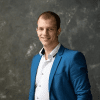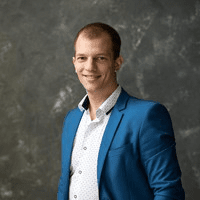Agile Discovery Process: Everything You Should Know
- Updated: Nov 14, 2024
- 13 min
You have come up with a great software project idea that will level up your business operations.
That’s great!
But, before kicking off the design and development, there are certain things you need to dive into.
These include the problem you’re solving and your target audience.
If your product provides a solution, your target audience must try to solve it.
This is when the discovery phase comes into play.
Most, if not all, software development projects should conduct the discovery phase in one way or another.
The discovery process allows product teams to cover the project in detail, answer some preliminary questions, and identify potential pitfalls.
In other words, the discovery phase helps avoid unnecessary frustrations with the final product.
There are different approaches to the discovery process.
In this article, we will focus on the Agile discovery process as it is one of the most comprehensive approaches to product discovery.
Let’s dive in.
Let's shape your startup's product vision together!
What is the Discovery Phase in Agile?
According to different studies, poor planning contributes to about 6% of startup failures.
Lack of adequate planning often leads to insufficient business models and unrealistic expectations.
That is why the product discovery process is an essential step before the actual development starts.
In Agile development, the discovery phase is the critical first step where a project team identifies the scope, goals, and feasibility of a product.
During this phase, the team works closely with stakeholders to clarify the business needs, user requirements, and potential challenges.
Research, both qualitative and quantitative, helps better understand the market, competitors, and users’ pain points.
As a result, the product team is able to create a product vision that aligns with both business goals and user expectations.
The discovery phase also involves building prototypes and running early tests to validate assumptions and reduce the risk of costly errors later on.
There can be multiple discovery phases within one project.
For example, if you decide to move your product on a cloud, you need to conduct cloud migration discovery phase.
This phase lays the groundwork for a successful migration to cloud technology.
If you are planning website development or update, you might need a web design discovery phase to understand better what design elements resonate with your brand identity and user experience.
By the end of this phase, the team produces key deliverables like user stories, technical specifications, and an initial project roadmap, which provides a clear direction for development.
This phase helps avoid major project pitfalls and ensures that the product being built is both valuable and feasible.
In Agile, it’s not a one-time event.
Instead, discovery continues throughout the project lifecycle to adjust as new information arises.
Explore the advantages of cloud-based app development to improve app performance and accessibility.
Why is the Agile Project Discovery Process Essential for Success?
Building a product is like constructing a house — you wouldn’t start laying bricks without a solid foundation.
In software development, that foundation is the Agile product discovery process.
It’s the stage where everything becomes clear, from the project vision to how you’ll avoid potential risks down the road.
Skipping this phase is like trying to build without blueprintіs. You might get something built, but it won’t be what you envisioned, and it will likely cost you more in the end.
Here’s why this phase is so crucial for everyone involved:
Well-Planned Budget
Getting your budget right from the start is essential.
The discovery process is where you lay the groundwork for that.
When you spend time planning upfront, you’re less likely to run into those expensive mistakes that could have been avoided.
Think of it this way: understanding exactly what needs to be built helps you avoid adding unnecessary features or running into budget overruns.
Plus, you’re not just saving money but also protecting your timeline.
No one likes the idea of missing deadlines because something unexpected came up.
Discovery helps you stay on track and make sure you know what’s coming next.
Complete Understanding of Your Product, Customer, and Competitors
In Agile, discovery is where you take a deep dive into the why of your product — why does it matter to your users? What problems are you solving?
This phase helps you focus on building what truly counts.
According to the Pendo Feature Adoption Report, almost 80% of product features are almost never used.
You spend a lot of time and money developing these features.
Discovery ensures you’re not wasting time building something no one needs.
Not only that, but this is where you’ll map out your product’s journey from idea to launch.
You’ll be setting clear goals and defining the steps to get there.
This roadmap isn’t just for you. It’s also a great tool to show investors or potential users exactly what you’re building and why it matters.
Get a clear picture of your customers’ lifetime value with this CLTV calculator. It’s designed to make insights quick and simple.
Unique Value Proposition and Well-Defined Market Positioning
Product discovery also helps you carve out your place in the market.
It’s where you figure out what makes your product unique and why people should care.
By spending time here, you’re not just building trust with your development team — you’re building a real partnership.
At the end of the day, product discovery keeps the focus on the people who matter most: your users.
You need to understand their needs upfront to deliver something that they’ll love.
And when your product is aligned with what users want, it has a much better chance of being successful in the long run.
When working with a development team, a solid partnership is key. Discover more in our app development partnership guide. 
7 Key Steps of the Agile Product Discovery Phase
The discovery process in Agile is broken down into several steps: initiation, planning, execution, control, and closure.
In modern Agile, you usually do the discovery phase in the first sprint.
It’s to make sure the development team and the client understand each other from the very beginning.
Agile product discovery phase is a complex process.
Here are seven key steps that lay the foundation for a successful product development process.
Let’s explore them in more detail.
1. Form a Discovery Team
The product team is a cross-functional group of specialists responsible for researching, analyzing, and defining the project’s needs.
Agile teams usually include product manager, business analysts, UX/UI designers, dedicated developers, and stakeholders.
Each of them has a different perspective on product development. It allows to focus on both technical and user-centric aspects of the product development.
As a result, there are higher chances that the final product is aligned with business objectives and meets user needs. 
Want to build a strong founding team? Start by learning how to find a technical co-founder.
2. Gather Requirements
Once the product team is formed, it is time to gather requirements.
At this stage of the agile product discovery process team members collect all necessary information about the business and technical requirements of the project.
The discussion of project requirements should include what success looks like from everyone’s point of view.
Let’s say you’re building an app for online food delivery.
You’d talk to restaurant owners, customers, and delivery staff to understand what they expect.
A restaurant owner might say, “I need to quickly update my menu items.”
The customer might want features like “I want to track my delivery in real time.”
These expectations get written down as user stories that describe what each type of user wants from the product.
Once you know what features are needed, you clarify what success looks like.
For instance, when a customer says, “I want to track my delivery,” you’d define the acceptance criteria, like: “the app should show the delivery status with an estimated time of arrival.”
Throughout this process, you also check if these requirements are realistic.
Can you build these features with the time and resources available?
If everything seems feasible, these requirements go into a backlog. 
3. Conduct User Research
After gathering the requirements, the next step in product discovery is user research.
This is where you dive deeper into understanding your users.
You study their behaviors, needs, and pain points.
Think of it as getting to know your customers better so you can design a product that truly helps them.
Let’s say you’re thinking of developing a fitness app.
During user research, you need to talk to potential users, observe their current habits, and maybe send out surveys to gather more data.
You might discover, for example, that many people struggle with sticking to their fitness routines because they forget to log their workouts.
Based on this, you could decide to add a reminder feature to the app that prompts users to log their workouts at specific times.
User research helps you eliminate the guesswork about what users want.
You base your product decisions on real data and insights.
Fitness apps are booming — learn the steps to make your fitness app and succeed in this growing market.
Types of User Research
There are different ways to conduct user research.
You might do qualitative research, like interviews and focus groups, where you gather more in-depth customer feedback from a smaller group of users.
Or, you could use quantitative research. This involves analyzing survey results or looking at user behavior data.
It gives you trends and patterns from a larger group of users.
For example, a report from UX Planet shows that 34% of startup failures are due to a lack of product-market fit.
It basically means the product wasn’t addressing the real needs of the users.
That’s why this research phase is so critical.
You need to make sure your product solves the right problems.
Through this research, you’re not just building features you think people will use — you’re making sure the product is something they will use because it fits their actual needs.

4. Define the Scope of Work
Now that you’ve done your user research and have a good sense of what people actually need, it’s time to define the scope of work.
This is basically the roadmap for the project.
It outlines what’s going to be included and what’s not.
You set boundaries so your product team doesn’t get overwhelmed halfway through the project by trying to add too many features.
Think of it as deciding, “Okay, we’re going to build a workout tracker, but we won’t add meal planning just yet because we need to stay focused.”
This keeps the team aligned and helps avoid what’s known as “scope creep,” where new features keep getting added and cause delays.
In fact, studies show that poor scope management is one of the leading causes of project failure.
With a clear scope of work, your team can stay on track and deliver the core features that users really need.
5. Agree on Technical Development
Once the scope is set, you need to have a conversation about technical development.
This is where the developers, architects, and stakeholders agree on how the product will be built from a technical standpoint.
They decide what technologies will be used, what any integration requirements will be, and how scalable the product needs to be.
For example, you might decide to build your workout app using React Native because it allows you to deploy on both iOS and Android quickly. Here’s a look at the best iOS app development tools for creating standout mobile apps.
This phase is crucial because it ensures that everyone is on the same page technically, which helps prevent costly rework later on.
If you’re planning to build an app, these detailed guides on Android app development costs and iOS app development costs will help you navigate the financial aspects.
6. Prototyping and Wireframes
The next stage in the Agile product discovery process is prototyping and wireframes.
This is when things start to get visual.
The designers create simple mockups (wireframes) of what the app will look like and how users will navigate through it.
These aren’t fully fleshed-out designs but rather basic layouts that show the structure.
Prototypes come into play when you want to test specific interactions. For example, you want to see how users log their workouts or check their progress.
You need to test the functionality early on to catch usability issues before spending too much time on development.
According to research by the Nielsen Norman Group, user testing with prototypes can improve the overall user experience by 39%.
It’s all about validating your design decisions before fully building out the app.
Explore examples of good web design that combine functionality and creativity.
7. Project Blueprint
Finally, once you have all the pieces in place, you create a project blueprint.
This is essentially the plan that outlines timelines, milestones, and who’s responsible for what.
Think of it as the instruction manual for the project: it helps the entire team know what’s coming up and keeps everything organized.
For instance, the blueprint will specify when the MVP (Minimum Viable Product) should be ready, how long testing will take, and when the final release is expected.
Project blueprint is the final step before you hit the ground running with development.
Whether you’re a startup or a seasoned pro, this guide on MVP design will save you time and money.
Scaling Product Discovery Process in Agile
To scale the product discovery process in Agile, you need to make sure that the key practices you use for smaller projects — like understanding users, validating ideas, and aligning on goals — can work efficiently as your team or organization grows.
When you scale, the first thing you want to do is keep discovery continuous.
Instead of thinking of discovery as something you do only at the start of a project, you need to continuously gather feedback from users and stakeholders throughout the entire process.
Even after you’ve launched a product, you still need to have regular check-ins with users to ensure the product is meeting their needs.
This helps you avoid falling out of touch with what your audience actually wants.
Another thing that becomes more important as you scale is collaboration between teams.
When multiple teams and specialists are involved: a business analyst, project manager, designer, and developer, it becomes crucial for every team member to share insights and communicate openly.
Without this, you could end up with disconnected parts of the product that don’t align well.
A big part of scaling is also about decentralizing decision-making.
In smaller teams, it’s easier to have a single person or small group make decisions.
But when you scale, you want different teams to be able to make decisions based on their expertise and the data they have.
If your development team learns something during usability testing that affects the code, they should be empowered to act on that without waiting for upper management approval.
This keeps things agile and responsive.
Check out these five usability testing ways that will help elevate your startup’s performance.
Shared tools also become more critical as you scale.
Teams need to work off the same platform, so they aren’t siloed.
For example, using tools like Jira or Confluence lets different departments track user feedback, design progress, and development tasks in one place.
This ensures that no one is out of the loop and everyone is aligned on the same goals.
Finally, alignment across the organization is key.
You need to make sure that every team understands the overall vision of the product.
This can be done through regular workshops or sync meetings where everyone comes together to discuss progress, challenges, and goals.
Imagine running a workshop where everyone from designers to marketers walks through a user story map together, ensuring that everyone is on the same page.
When done right, the Agile discovery phase helps large teams stay just as agile and user-focused as smaller ones, keeping everyone on track to build products that genuinely meet user needs.
Here is a SCALE mnemonic to help you remember it better:
- Systematize continuous discovery
- Collaborate across teams
- Autonomize decision-making
- Leverage shared tools
- Ensure alignment

How Much Does a Discovery Phase Cost?
The discovery phase cost depends on various factors such as project complexity, tech stack, team location and expertise, and even the industry you work in.
You can learn about software development pricing by region in our article, where we discuss the top 10 countries to outsource software development.
It is usually priced at 10% of the development budget.
So, if your development cost is around $50,000, then the discovery phase will cost approximately $5,000.
Once the initial project concept is set and clear, the developers have a rough idea of the development route, development stacks, and functionality.
Hence, knowing the price of the discovery stage can tell you how much the final product will cost.
At SpdLoad, the discovery phase cost is carried out uder a Time & Material model. The final price is based on hourly rates and the working time of the discovery team involved in the process.
This is a simple and transparent way to deliver high-quality services at reasonable prices.
As for the timeframes, the discovery phase can be as short as a couple of days or as long as a couple of months.
Everything depends on the project’s complexity and scope:
- For small projects, the discovery stage takes 1-3 days.
- For medium-complexity projects — 1-2 weeks.
- For large and complex projects — 3-4 weeks and more.
Best Practices for Conducting the Discovery Phase
Wrapping up, project discovery is much more than just user and market research.
In fact, discovery doesn’t have to involve every research method.
In an ideal world, you would conduct a large study, perform usability tests of the user’s current experience, conduct stakeholder and user interviews, and listen in on customer support calls.
It would take you 2-3 months to finish your discovery phase.
However, we don’t live in an ideal world, and the market is moving rapidly, so we have to adapt and optimize software development processes.
Hence, you should prioritize the most valuable discovery activities to get the missing information in the time you have.
Align activities to specific questions or assumptions to keep the scope and timeline realistic.
After all, the product discovery process in Agile is about understanding problems and opportunities in small but feasible iterative increments.
You want to be specific about what discovery activities are valuable and how much time should be spent on them.
It will help you collect all the data you need to make informed decisions regarding your product development.
At SpdLoad, we help businesses conduct a robust discovery process using Agile methodology.
During product discovery, we create well-planned requirements that will eliminate risks and provide clear budget estimates.
Our product discovery process aligns with agile development as it focuses on iterative learning and validation.
This way, we ensure that the product evolves based on real user feedback and market changes.
Ready to get the discovery process started?
Let’s get in touch to discuss your business objectives and see how our discovery team can provide you with a deep understanding of your market, audience, and development timelines.













